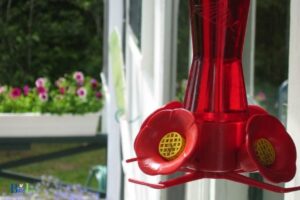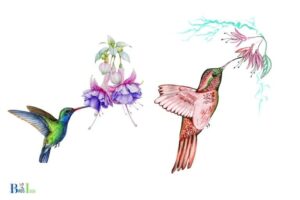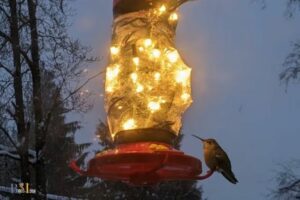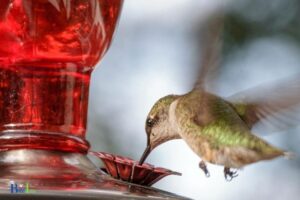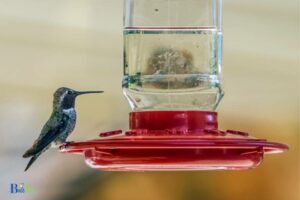How to Keep Orioles Away from Hummingbird Feeders: Relocate
To keep orioles away from hummingbird feeders, use specialized oriole feeders, relocate the feeders, adjust the nectar concentration, and provide alternative food sources.
Orioles and hummingbirds are both attracted to nectar as a primary food source, so it’s common to find orioles visiting hummingbird feeders.
However, it’s essential to provide separate feeding stations to cater to their specific needs and prevent competition between these two bird species.
Additionally, adjusting the nectar concentration to a 4:1 water to sugar ratio is less appealing to orioles and more suitable for hummingbirds.
Lastly, providing alternative food sources such as fruit and jelly for orioles can keep them attracted to their designated feeding area and away from hummingbird feeders.
7 Methods on How to Keep Orioles Away from Hummingbird Feeders:
| Method | Description | Additional Notes |
| Use Oriole Feeders | Provide oriole-specific feeders with larger feeding ports and perches. | Orioles will be more attracted to feeders designed for them, reducing their visits to hummingbird feeders. |
| Different Locations | Place hummingbird and oriole feeders in separate areas of your yard. | Orioles and hummingbirds will be more likely to stick to their respective feeders if they are not in close proximity. |
| Oriole Friendly Foods | Offer orioles their favorite food sources, such as oranges, grape jelly, and mealworms. | Providing preferred oriole food will make the hummingbird feeders less appealing. |
| Use Bee Guards | Attach bee guards to the hummingbird feeder ports. | Bee guards have small openings that can help deter orioles from accessing the nectar. |
| Reduce the Amount of Yellow | Choose hummingbird feeders with less yellow decoration, as this color attracts orioles. | Orioles are highly attracted to yellow, so reducing this color around hummingbird feeders may help. |
| Install a Slinky | Attach a slinky to the top of the hummingbird feeder pole to prevent orioles from climbing down. | Orioles may find it difficult to reach the feeder with the slinky in place. |
| Add a Feeder Moat | Install a water-filled moat above the hummingbird feeder to deter orioles and ants. | Orioles may be less likely to visit a feeder if they have to pass through a water barrier. |
Key Takeaway

Four Facts About: Keep Orioles Away from Hummingbird Feeders
Understanding The Problem
The Problem: Orioles Eating From Hummingbird Feeders
Hummingbird feeders are often visited by orioles who eat the nectar intended for the hummingbirds. Orioles can be seen as a beautiful addition to your garden, but they pose a problem to hummingbirds.
Orioles have a strong beak, and they can tear apart the plastic feeders.
Orioles have also been observed attacking hummingbirds to steal their nectar, leading to aggression and territorial disputes.
To give you an idea of how dangerous this problem can be for hummingbirds and songbirds, a study conducted by the wildlife research center concluded that orioles can eat up to 6 times more nectar than hummingbirds, leading to malnutrition and dehydration among hummingbirds.
The problem is not limited to the safety of hummingbirds; it also leads to additional feeding costs, as orioles consume more nectar, resulting in an increase in the frequency of refilling hummingbird feeders.
Why It Matters: Safety Of Hummingbirds And Feeding Costs
It is important to protect hummingbirds because of their important ecological role, including pollination and controlling insect populations.
When orioles take over the hummingbird feeders, they eat more than necessary, leading to malnutrition and dehydration among hummingbirds.
This aggressive behavior can also become a territorial problem, leading to reduced bird activity in your garden.
On the other hand, as orioles consume more nectar from hummingbird feeders, it results in an increase in the frequency of refilling hummingbird feeders, leading to additional feeding costs.
The Importance Of Finding A Solution
It’s essential to find a solution to keep orioles away from hummingbird feeders. Here, we are not only concerned about the safety of hummingbirds, but also finding a cost-effective solution for maintaining hummingbird feeders.
It’s important to create a safe environment for hummingbirds to thrive and attract them to your garden.
Additionally, reducing feeding costs by creating oriole-proof hummingbird feeders can provide tremendous benefits in the long run.
Natural Ways To Deter Orioles
How To Keep Orioles Away From Hummingbird Feeders
Have you ever tried feeding your hummingbirds, only to find out that you’re also feeding the orioles? Orioles can be territorial and intimidating to hummingbirds, and they can quickly drain your feeder.
No worries, though. With a bit of knowledge, you can keep orioles away from your hummingbird feeders without harming them.
In this post, we’ll be discussing natural ways to deter orioles.
Choosing The Right Hummingbird Feeder
Choosing the right hummingbird feeder is essential in keeping orioles away.
Here are some tips to choose the right one:
- Select a feeder with bee guards. Orioles are attracted to the color orange, and bee guards can block them from reaching the nectar.
- Choose a feeder with smaller ports. While hummingbirds can fit through small ports, orioles are too large to do so.
- Avoid feeders with perches. Since orioles are larger, they need perches to drink from. Hummingbirds can feed while hovering.
Optimize Your Feeding Schedule
Optimizing your feeding schedule can also help deter orioles.
Here are some tips:
- Limit the amount of nectar in the feeder. Orioles prefer the same sugar-water mix as hummingbirds, so reducing the amount of nectar available can help discourage them.
- Refill the feeder after sunset. Orioles feed during the day, while hummingbirds feed at dawn and dusk. Refilling the feeder after sunset can reduce the chances of orioles draining it.
Location, Location, Location: Best Placement For Your Feeder
The location of your feeder can have a significant impact on whether orioles visit it.
Here are some tips:
- Hang your feeder in a shaded area. Orioles love the sunlight, so hanging your feeder in the shade can reduce their interest in it.
- Hang it in a location with good visibility. Hummingbirds are more likely to use feeders that are easy to spot, while orioles prefer more secluded areas.
- Keep it away from plants that attract orioles. Orioles are attracted to fruit trees, berry bushes, and flowering plants. Make sure your feeder is not too close to any of these.
Adding Orange To Your Garden: Plants And Fruit As A Deterrent
Adding orange to your garden can also be an effective way to deter orioles.
Here are some tips:
- Plant marigolds, zinnias, and butterfly weed. Orioles are attracted to these plants and will feed on them instead of your feeder.
- Hang orange slices near your feeder. Orioles will be drawn to the orange, and this can help divert their attention away from your feeder.
- Avoid planting fruit trees or berry bushes near your feeder. As mentioned earlier, orioles are attracted to these plants, and having them too close to your feeder can be counterproductive.
There are many natural ways to deter orioles from your hummingbird feeders.
By choosing the right feeder, optimizing your feeding schedule, placing it in the right location, and adding orange to your garden, you can successfully keep orioles away without harming them.
Diy Solutions To Protect Your Hummingbird Feeder
Hummingbirds are a joy to behold, flitting about, sipping nectar from colorful feeders. The vibrant colors of their feathers may attract other birds as well, most notably orioles.
While it is wonderful to enjoy the company of several birds, too many might leave the hummingbirds with less nectar or worse, scare them away.
Keeping orioles away from hummingbird feeders may sound difficult, but there are a few diy solutions to protect your feeder.
Creating an oriole-proof feeder:
- Feeders with tight-fitting lids are oriole-proof because the birds can’t figure out how to lift the lid.
- Using an oriole-proof feeder with a built-in perch is another effective way.
- If you want to be more diy about it, you can retrofit an old feeder by simply gluing flat plastic lids to the feeding ports. This way, the orioles won’t be able to stick their bills in.
Distracting orioles with alternative food sources:
- Creating an oriole feeding station that’s a short distance away from the hummingbird feeder can be helpful. Orioles can be drawn to cut oranges, grape jelly, and even mealworms.
- By diverting their attention this way, your hummingbirds can enjoy their nectar without having to share.
Adding obstacles: string and glitter as deterrents:
- Hang a hank of red string or cord near the hummingbird feeder to keep orioles from coming too close.
- Orioles are attracted to shiny, colorful items so hanging strips of glittery material near the feeder can be helpful as deterrents.
Keeping orioles away from your hummingbird feeder may seem like a challenge, but there are ways to do it.
Creating an oriole-proof feeder or distracting them with alternative food sources or adding obstacles such as string and glitter are effective measures.
By taking these steps, you can enjoy your hummingbirds without having unwanted guests.
Store-Bought Products To Keep Orioles At Bay
Oriole-Proof Feeders And Accessories
Bird lovers who enjoy attracting hummingbirds to their yard have likely encountered the issue of orioles also visiting their hummingbird feeders.
Fortunately, there are a number of store-bought products that can help keep orioles away from the hummingbird feeders.
- Oriole-proof feeders are specifically designed to keep away larger birds, including orioles. These feeders have a locking mechanism that only allows smaller birds, such as hummingbirds, to feed.
- Another option is to use accessories that make it difficult for orioles to reach the feeder. These include feeding stations that use long tubes to reach the nectar and saucer-style feeders with a hood that covers the nectar and provides protection from larger birds.
Bird Repellent Sprays And Gels
If orioles continue to be a nuisance even with oriole-proof feeders and accessories, bird repellent sprays and gels can be helpful.
Here are some things to keep in mind:
- Not all bird repellents are created equal, so do your research to find a reputable brand.
- Make sure the repellent is safe and won’t harm the birds or other wildlife.
- Follow the instructions carefully to avoid over-applying the repellent, which can be harmful to both birds and humans.
- Keep in mind that repellent sprays and gels may need to be reapplied regularly.
Electronic Bird Deterrents
If you’re looking for a more high-tech solution, electronic bird deterrents may be a good option. These devices emit high-pitched sounds that are unpleasant to birds, but undetectable to humans.
- Electronic bird deterrents come in various models, including motion-activated and timer-activated options.
- Do your research and ensure the device you choose has good reviews and a solid return policy.
- Keep in mind that electronic bird deterrents may only work for certain types of birds and in specific situations. They are not a guaranteed solution and may not be effective in every instance.
By using oriole-proof feeders and accessories, bird repellent sprays and gels, or electronic bird deterrents, you can enjoy watching hummingbirds in your yard without being bothered by pesky orioles.
Remember, it may take some trial and error to find the right solution for your specific situation, but with patience, you’ll find what works for you and your feathered friends.
Long-Term Oriole Management
Understanding The Relationship Between Hummingbirds And Orioles
Hummingbirds and orioles share habitat and diet similarities, making it a challenge to prevent orioles from feeding at hummingbird feeders. Understanding their relationship can help you manage your feeders better.
Here are some key points to consider:
- Hummingbirds prefer nectar, while orioles prefer insects, fruit, and nectar.
- Late spring is the peak season for orioles, and they tend to be more territorial during this time.
- Orioles are attracted to the color orange, so avoid feeding hummingbirds a mix that contains orange dye, and choose an orange color for oriole feeders instead.
Record-Keeping And Consistent Observations
Keeping track of oriole sightings can help you predict when they are likely to visit your feeders and adjust your management strategy accordingly.
Here are some tips on record-keeping and observations:
- Record the first and last sightings of orioles in your area each year on a calendar.
- Keep track of the number of orioles that visit your feeder daily.
- Observe the feeder frequently and at different times of the day to know when the orioles visit most and adjust accordingly.
Participating In Citizen Science Programs
Citizen science programs are an excellent way to contribute to scientific research while gaining valuable information about oriole management.
Here are some things to consider when participating in a citizen science program:
- Participate in backyard birding surveys such as ebird where you can submit your sightings.
- Join a feeder watch program where data is collected on the number and types of birds at your feeder.
- Use the data collected from these programs to inform your own record-keeping and management strategies.
By using a combination of understanding their relationship, record-keeping and observations and participation in citizen science programs can decrease the number of oriole visits to hummingbird feeders in the long run.
FAQ For How To Keep Orioles Away From Hummingbird Feeders
How Do Orioles Get Attracted To Hummingbird Feeders?
Why Are Orioles Harmful To Hummingbirds?
What Are The Ways To Keep Orioles Away From Hummingbird Feeders?
What Kind Of Food Do Orioles Eat?
Conclusion
It’s no secret that orioles can be a real problem for hummingbird enthusiasts. However, now that you’ve read this guide, you have the tools and information you need to keep these pesky birds at bay.
Remember to choose the right food, place your feeders strategically, and provide alternative options for orioles.
By doing so, you’ll create an environment that’s friendly to hummingbirds and less welcoming to their competitors.
Finally, don’t forget to clean and maintain your feeders regularly, as this simple step will attract hummingbirds while keeping orioles away.
With these tips in mind, you’ll be able to enjoy the beauty and grace of hummingbirds without worrying about their feathered foes.
Happy bird-watching!

